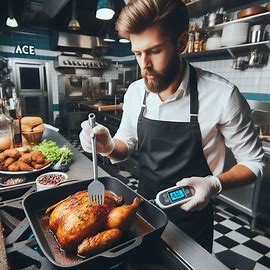Cooking to Perfection: The Art of Safe Temperatures
When it comes to creating culinary masterpieces, precision matters. Whether you’re a seasoned home cook or a budding chef, understanding correct cooking temperatures is your secret weapon against foodborne illnesses. Let’s dive into the sizzling world of food safety and explore how to wield the thermometer like a pro.
The Danger Zone
Picture this: You’re hosting a backyard barbecue, and the grill is fired up. But lurking in the shadows is the notorious danger zone—that temperature range where bacteria throw a party. The FDA defines it as above 40°F and below 140°F. Within this zone, bacteria like Staphylococcus aureus and Salmonella multiply faster than rabbits on caffeine. 🐇
- Above 140°F: Bacteria start to surrender and die off.
- Below 40°F: Bacteria take a nap, waiting for warmer times.
Safe Minimum Internal Temperatures
Let’s get practical. Here are the magic numbers for safe cooking:
- Beef, Pork, Veal & Lamb:
- Steaks, chops, roasts: 145°F (62.8°C) with a 3-minute rest.
- Ground meats: 160°F (71.1°C).
- Ground poultry: 165°F.
- Ham (fresh or smoked, uncooked): 145°F with a 3-minute rest.
- Fully cooked ham (reheating): 140°F (60°C) from USDA-inspected plants, or 165°F (73.9°C) otherwise.
- All Poultry:
- Breasts, whole bird, legs, thighs, wings, ground poultry, giblets, and stuffing: 165°F.
- Eggs: Prepared for immediate service: 160°F (71.1°C).
- Fish & Shellfish: 145°F (62.8°C).
- Leftovers & Casseroles: 165°F (73.9°C).
Remember, these are the minimum internal temperatures. If you’re a flavor perfectionist, chefs often account for a little extra rise after cooking to prevent dryness. 🍖🔥
The 2-Hour Rule
Reality check: We can’t keep food out of the danger zone 100% of the time. Groceries sit in the car, and picnics happen. So, follow the 2-hour rule:
- Perishable food out longer than 2 hours? Toss it.
- On a scorching day (above 90°F)? Cut that time to 1 hour.
Why It Matters
Food safety isn’t just about avoiding tummy troubles. It’s about protecting your loved ones. So, wield your spatula with confidence, and let the thermometer be your culinary compass. 🌡️👨🍳






